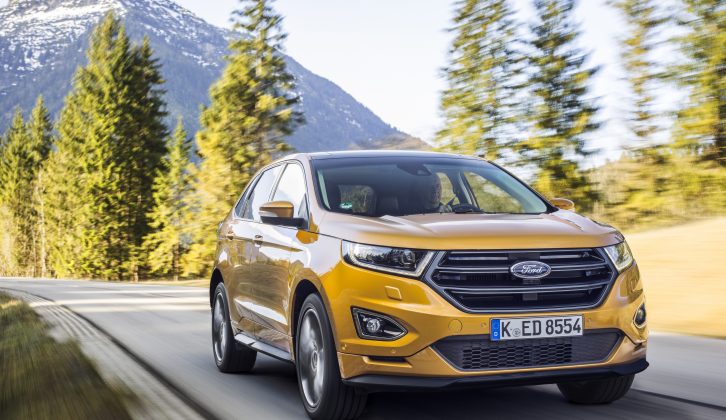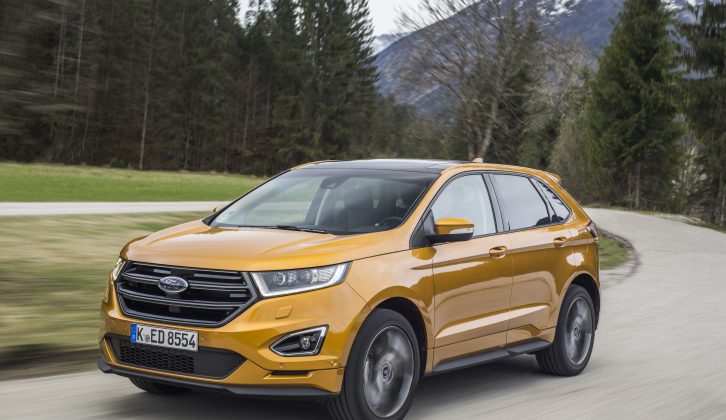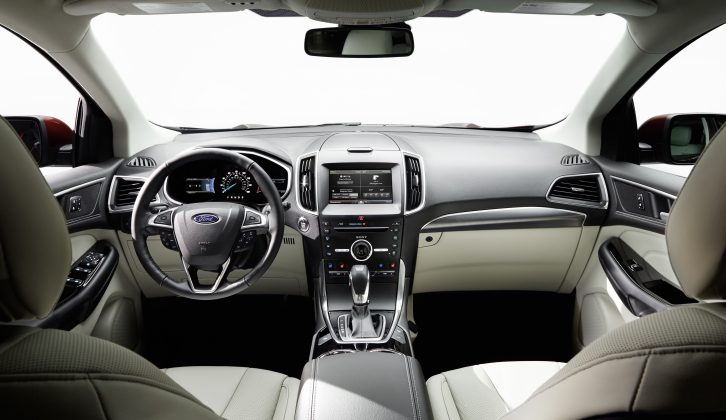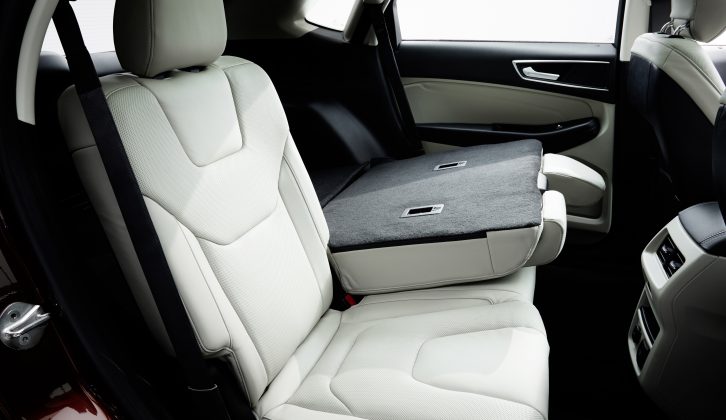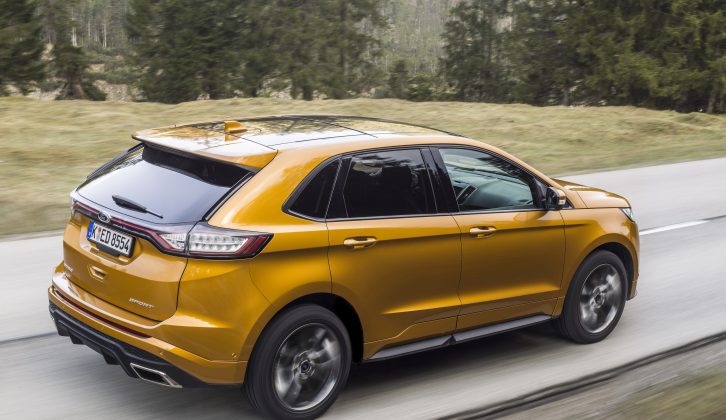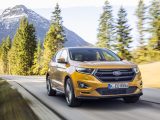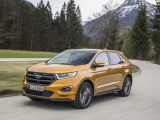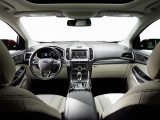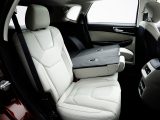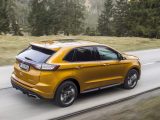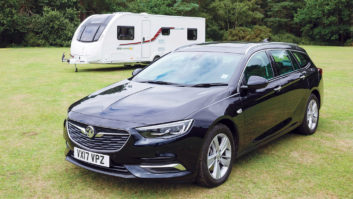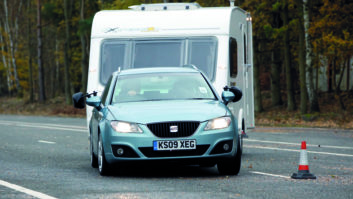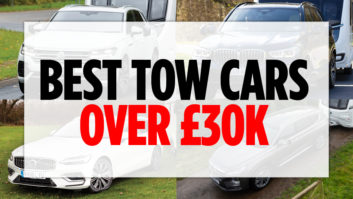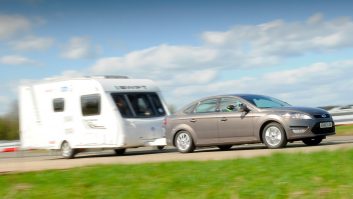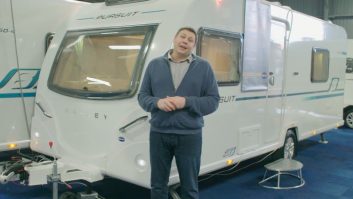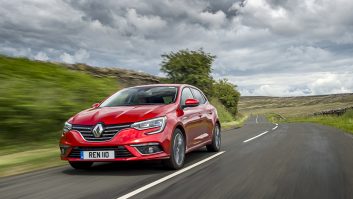Which is the fastest growing SUV brand in Britain? Land Rover? Mitsubishi, perhaps? It may surprise you to learn that it’s Ford, which saw a 63% increase in SUV sales last year. And that was without its new range-topper, the Edge.
Sitting above the compact Ecosport and the family friendly Kuga, the Edge is gunning for prestige-badged rivals like the Audi Q5 and BMW X3. It’s also hoping to win over customers from big, practical mainstream SUVs like the Hyundai Santa Fe and Kia Sorento.
The new Ford Edge has the makings of a strong tow car. Kerbweights start from 1913kg for the 2.0-litre 180PS six-speed manual, giving an 85% match figure of 1626kg. That increases to 1949kg for the six-speed Powershift auto, which puts the 85% figure up to 1657kg. In either case, the legal towing limit is two tonnes, and the maximum noseweight is 90kg.
Ford expects six out of 10 buyers to choose the more powerful engine with the automatic gearbox. With 332lb ft of torque, it has more pulling power than either the Hyundai Santa Fe or Kia Sorento, which ought to be enough for punchy acceleration. The Edge’s straight-line performance feels surprisingly subdued, though, in part because the gearbox takes its time changing down to a lower gear. With the gearbox in Sport mode or using the paddles behind the wheel to grab the right gear the Edge feels less lazy, but even then it accelerates doggedly rather than with real vigour.
The 180PS manual car has 295lb ft of torque – significantly less than the more powerful auto – but on the road it feels much closer in performance than that difference would suggest. There’s no difference in fuel economy: both engines return 48.7mpg on the combined cycle riding on 19-inch alloys, and 47.9mpg on 20-inch wheels.
In either state of tune, Ford has done a fine job of keeping the engines quiet. There’s no doubt that a four-cylinder diesel is under the bonnet, but any noise is subdued and distant. It’s not just down to the fundamental refinement of the engine; there’s some clever technology at work here called Active Noise Control. It works rather like noise-cancelling headphones by emitting sound waves which counteract unwanted noise from the engine, the transmission, or the air passing over the car.
How effective is it? Without being able to try the car without the technology (which comes as standard on all versions except the entry-level Zetec), it is hard to say. Acoustic glass (standard on Titanium and Sport cars) also helps keep sounds from outside the car at bay, so the big Ford is really very quiet at speed, with little road or wind noise at 70mph. It’s at least a match for its key rivals, and more hushed than most.
The Edge is comfortable as well as quiet at speed. The more powerful car we drove was in range-topping Sport spec, which rides on 20-inch alloy wheels and (as the name implies) sports suspension. Even this set-up rides serenely and quietly. Our driving took place on smooth roads in southern Germany, but even when we went looking for potholes and manhole covers to thump into, we couldn’t upset the car.
The less powerful version was in Titanium spec, riding on standard suspension and 19-inch alloy wheels. On undulating roads the body control felt slightly less firm, but this model was even more forgiving of whatever rough roads we could find. In the UK, where poor surfaces are the norm rather than the exception, we’d bet the standard set-up on 19-inch wheels will be the one to go for. Either way, the combination of comfort and control bodes well for stability when towing a caravan or trailer.
Without a caravan behind it, the Edge corners neatly, but it’s not as agile or alert as you might expect of a Ford. Whereas a BMW X3 feels smaller than it really is from behind the wheel, you never quite forget the Edge’s size and bulk.
The standard steering is accurate, although there’s a very strong self-centring action. Sport models have Adaptive Steering. At lower speeds, it takes fewer turns to achieve full lock. At higher speeds, the driver has to move the wheel further so the car doesn’t feel nervous. At least that’s the theory. It takes a little getting used to, although the more we drove with the system, the more we liked it.
It took no time at all to be impressed with the Edge’s interior. The fit and finish won’t have Audi worried, but it stands comparison with more mainstream rivals. There’s lots of useful storage around the cabin, and loads of room. A passenger of 6ft 3in can comfortably sit behind an equally tall driver with kneeroom to spare, although headroom is tight in cars with the panoramic sunroof (an £800 option on Titanium and Sport models). It’s good to see air vents between the two front seats to keep those in the back of the car at a comfortable temperature.
The width of the car is a plus if you travel with three passengers in the back, and the transmission tunnel is quite small so it doesn’t get in the way too much.
There’s no third row of seats – which could be a deal-breaker for some – but Ford argues it already offers the Kuga with seven seats, and there are 4×4 versions of the seven-seat S-Max and Galaxy.
A benefit of having just five seats is that luggage space is very generous. There’s 602 litres with the rear seats upright. With the back seats down there’s a slight slope to the floor, but a huge 1847-litre capacity.
Prices start from £29,995. That buys you the Zetec, which Ford expects just 2% of customers to choose. It comes with 19-inch alloys, an eight-inch touchscreen, a DAB radio, a rearview camera, rain-sensing wipers, automous emergency braking and more.
Ford predicts a more or less even split between the two other trim levels. Titanium, priced from £32,245, would be our pick of the range. The extra spend adds lots more kit, including satellite navigation, front and rear parking sensors, heated front seats, a powered tailgate, Active Noise Control, acoustic glass and a 220v power socket.
The Sport costs upwards of £34,495, and comes with 20-inch black alloy wheels, a 12-speaker stereo, Adaptive Steering, sports suspension, alloy pedals and a sporty-looking body kit.
These are stiff prices for a Ford. However you’d have to pay a lot more for a prestige-badged alternative with similar kit, and the Audi Q5 and BMW X3 aren’t as spacious inside. You may worry how much of that outlay you would get back in three years or so, but used car valuation company CAP has predicted the Edge will hold its value better than an Audi Q5, BMW X3 or Volvo XC60. Time well tell if those predictions are accurate.
The Edge is a worthwhile and capable addition to the segment. Comfort, refinement and interior space are its chief strengths. But it’s a solid all-rounder rather than the new standard-setter.
Kerbweights start from 1913kg for the 2.0-litre 180PS six-speed manual, giving an 85% match figure of 1626kg
